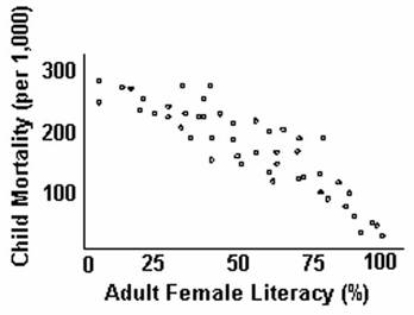A) the highest
B) an intermediate
C) the lowest
D) an equal
E) It is impossible to use the data in the table to identify the rate of female literacy.
Correct Answer

verified
Correct Answer
verified
Multiple Choice
Refer to the following graph for the question.  -Family planning means enabling people to
-Family planning means enabling people to
A) have fewer children so that the population growth rate can reach ZPG.
B) have no children.
C) have many children.
D) decide in advance how many children they should have.
E) have more children if they live in a country with a birth dearth.
Correct Answer

verified
Correct Answer
verified
Multiple Choice
According to Joel Cohen, the maximum human population that Earth can support is
A) 7-8 billion.
B) 10-12 billion.
C) 15-18 billion.
D) 20-22 billion.
E) more than 26 billion.
Correct Answer

verified
Correct Answer
verified
Multiple Choice
Technological optimists argue that technological advances have
A) led to the increase in human population but whether we can continue is of great concern.
B) proven Marx wrong in his predictions of famine and disaster.
C) proven Malthus wrong in his predictions of famine and disaster.
D) been developed because there are more people, supporting the view that more people are the "ultimate resource."
E) been a neutral factor in the issue of population growth.
Correct Answer

verified
Correct Answer
verified
Multiple Choice
The concept that incorporates human population numbers and the types of resources used is referred to as the
A) IPAT concept.
B) demographic transition concept.
C) ecological footprint concept.
D) social justice concept.
Correct Answer

verified
Correct Answer
verified
Multiple Choice
The annual percentage rate of this population is
A) 0.02%.
B) 2.0%.
C) 20%.
D) -0.02%.
E) -2%.
Correct Answer

verified
Correct Answer
verified
Multiple Choice
A population growing at 1% per year should double in about ___ years.
A) 30
B) 70
C) 10
D) 2
E) 0.7
Correct Answer

verified
Correct Answer
verified
Multiple Choice
A population would have zero population growth if
A) births + immigration = deaths + emmigration.
B) births + immigration > deaths + emmigration.
C) births + immigration < deaths + emmigration.
D) births = deaths.
Correct Answer

verified
Correct Answer
verified
Multiple Choice
Use the following demographic data on three hypothetical countries to answer the question.
 -Which of the following demographic categories best identifies Country "A"?
-Which of the following demographic categories best identifies Country "A"?
A) developed
B) moderately developed
C) less developed
D) developing
E) third world
Correct Answer

verified
Correct Answer
verified
Multiple Choice
The doubling time for a population with an annual growth rate of 0.07 is rev: 03_26_2013_QC_28345
A) 1 year.
B) 5 years.
C) 1000 years.
D) 50 years.
E) 100 years.
Correct Answer

verified
Correct Answer
verified
Multiple Choice
Use the following demographic data on three hypothetical countries to answer the question.
 -The most industrialized country listed is
-The most industrialized country listed is
A) Country "A."
B) Country "B."
C) Country "C."
D) None of the countries listed are likely to be industrialized.
E) It is impossible to use the data in the table to identify an industrialized country.
Correct Answer

verified
Correct Answer
verified
Multiple Choice
Which of the following has not played an important role in the slowed population growth rate of Iran?
A) Mandatory family planning classes before marriage.
B) A strictly enforced government limit on the number of children per family.
C) A wide variety of free contraceptives.
D) Improved gender equity.
E) Availability of better jobs.
Correct Answer

verified
Correct Answer
verified
Multiple Choice
What is the dependency ratio?
A) The number of children men support.
B) The percentage of women who work outside the home.
C) The amount of people that can be supported by an acre of land.
D) The number of literate adults relative to the total number of adults in a population.
E) The number of nonworking compared to with working individuals in a population.
Correct Answer

verified
Correct Answer
verified
Showing 21 - 33 of 33
Related Exams